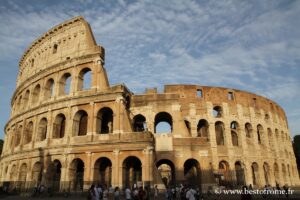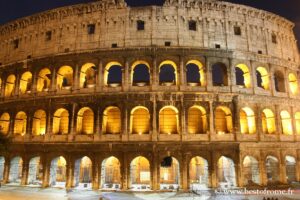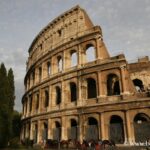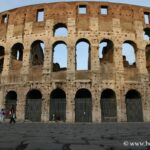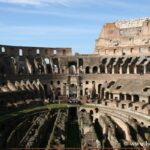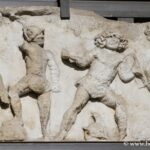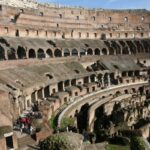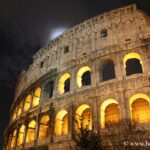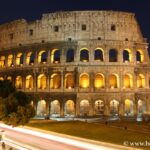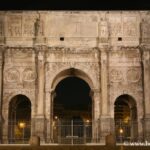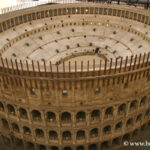In italian : Colosseo
The Colosseum: Rome’s Timeless Icon
The Colosseum is undoubtedly Rome’s emblematic monument and the largest amphitheater of ancient Rome. This extraordinary structure continues to captivate visitors, whether first-timers or regulars. In every season, a visit to the Colosseum is always enchanting: from the summer bustle under a radiant sun to the serenity of winter evenings shrouded in mist.
Visiting the Colosseum and the Roman Forum ranks number 1 in our Top 30 must-see sites in Rome.
Colosseum Information and Hours
! This information may be outdated, as conditions change regularly; please refer to the official website for the most accurate details.
The Colosseum (Colosseo in Italian)
Piazza del Colosseo, Colosseo metro station on line B
Ticketing website, official archaeological park website
The Colosseum is open daily, except on December 25 and January 1:
– From October 27, 2024, to March 29, 2025: 8:30 AM – 4:30 PM (last admission at 3:30 PM)
– From March 30 to September 30: 8:30 AM – 7:15 PM (last admission at 6:15 PM)
The ticket office closes one hour before the site’s closing time.
The ticket includes entry to the Colosseum, Roman Forum, and Palatine Hill. It is valid for 24 hours. Note: Only one entry per site is permitted; re-entry is not allowed after exiting.
Full price €18; reduced price €2 for European Union residents aged 18 to 25; free for those under 18 and other eligible categories.
See other pricing conditions and options on the official website (including access to underground areas, arena, Colosseum terrace, etc.).
Colosseum Tours, Tickets, and Entry
Guided tour options and skip-the-line tickets for the Colosseum, Roman Forum, Palatine Hill, etc. Check the languages in which these activities are offered.
A Brief History and Description of the Colosseum
Originally named the Flavian Amphitheater, the Colosseum was commissioned by Emperor Vespasian in AD 72. Its construction was completed in AD 80 by his son Titus and later enhanced by Domitian. Located near the eastern entrance of the Roman Forum, this structure could accommodate up to 55,000 spectators, thanks to its 80 vaulted entrances that facilitated quick and smooth circulation.
A Monumental Architecture
The Colosseum, elliptical in shape, measures 188 meters in length and 156 meters in width, reaching a height of 48 meters. Its imposing travertine façade is characterized by a succession of three superimposed colonnades, each comprising 80 arches. These arches are separated by half-columns of distinct styles: Doric-Tuscan for the lower level, Ionic for the middle level, and Corinthian for the upper level.
Above these levels stands an attic of composite style. In antiquity, this fourth level was adorned with 40 bronze shields, symbolizing the shields of enemies vanquished by the Roman army. The holes visible today on this structure were once used to fix the poles that supported the vast velum, a canvas deployed to protect spectators from the sun and rain, using 240 masts.
The central oval arena, 86 meters long, was surrounded by a 4.5-meter-high wall, protecting spectators from the fierce combats that took place there and preventing beasts or gladiators from escaping.
Degradations and Reuse of Materials
From the Middle Ages onwards, the Colosseum served as a quarry for the recovery of construction materials. The extracted stones were notably used to build prestigious monuments such as St. Peter’s Basilica. The numerous holes visible on its façade result from the extraction of metal clamps that once bound the stone blocks together.
Games and Shows at the Colosseum
Designed as an economic and political project, the Colosseum was notably a propaganda tool allowing the imperial family to strengthen its popularity. Spectators, from all Roman social classes, both rich and poor, came for entertainment. They attended gladiator combats and animal fights. The emperor himself was often present during the shows.
The inaugural games of the year 80 were marked by a grand spectacle: more than 5,000 animals and 2,000 gladiators met their deaths. The gladiators were mainly slaves, prisoners of war, or condemned criminals, mostly men.
A day of games was considered successful if, by its end, the arena was sufficiently bloodied to require a new layer of sand.
The Arch of Constantine: A Prestigious Neighbor
Near the Colosseum stands the imposing Arch of Constantine (Arco di Costantino in Italian), built in the year 315 on the Via Triumphalis to celebrate Emperor Constantine‘s victory over Maxentius at the Battle of the Milvian Bridge.
With its 21 meters in height, this triumphal arch is the largest in Rome. It is distinguished by its numerous sculpted reliefs, repurposed from older monuments. This practice, increasingly common from the 4th century onwards, was probably motivated by the need to build quickly, possibly combined with a shortage of skilled sculptors in the city.
Selection of Accommodations Near the Colosseum
Selection of hotels, rooms, and apartments near the Colosseum, sorted by price or by distance from the archaeological sites.
- Good hotels and accommodations sorted BY
PRICE within 600 meters of the Colosseum - Good hotels and accommodations sorted BY DISTANCE from the Colosseum
Photo Gallery
- Exterior of the Colosseum
- Exterior of the Colosseum
- Inside the Colosseum
- Gladiators
- Inside the Colosseum
- Colosseum
- Night view
- Arch of Constantine
- Model of the Colosseum
More Information
Links and Sources
- On Wikipedia: the Colosseum, the Arch of Constantine
- On Rome-Roma: The Colosseum, the Arch of Constantine
- Portals: www.turismoroma.it
Where is the Colosseum and Map
If you see this after your page is loaded completely, leafletJS files are missing.
Tips for Visiting the Colosseum
- Buy your tickets in advance Queues can be very long during the tourist season. Book via the official website or on a platform, ideally a combined ticket with the Roman Forum and the Palatine: GetYourGuide or Tiqets.
- Choose the timing and plan the duration
In July-August, it can get very hot, and the tourist crowds are significant. The ideal time is at opening (8:30 or 9:00) on weekdays when there are fewer people, or in the late afternoon around 4:00 or 5:00, but you will be limited by the closing time.
Expect nearly 1.5 to 2.5 hours for some complete guided tours. - Opt for a guided tour or a complete ticket
Many fascinating details or historical elements are missed without a guided tour. Check the offers on GetYourGuide.
Choose an entrance ticket or a guided tour that includes the upper levels (including the panoramic terrace) and the underground areas. - Prepare for security checks: bag searches, prohibited items such as knives, drones, and large backpacks.









